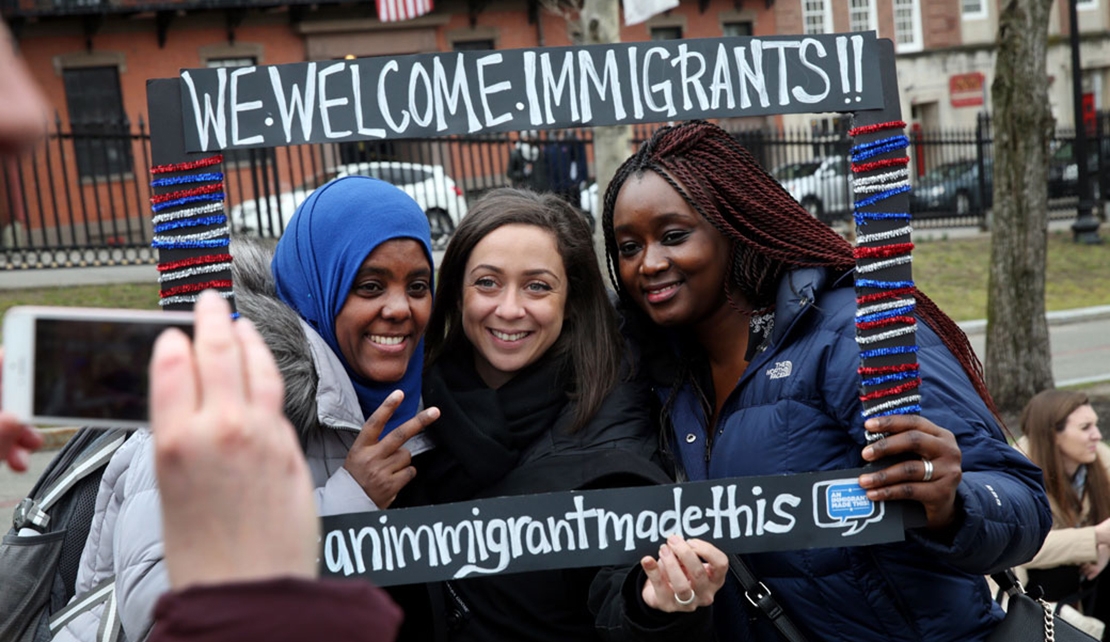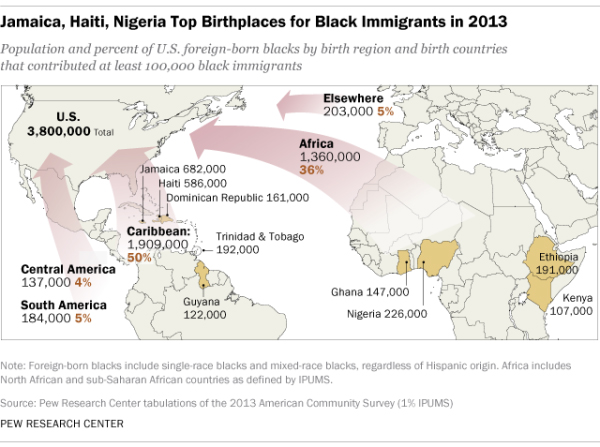UNITED STATES | Black immigrant population in US set to double says Pew Study

There is a growing shift in the demographics of America’s Black immigrant population which is set to more than double to 9.5 million by 2060 says data coming out of the Pew Research Centre.
Of the approximately 4.6 million Black people in the United States, roughly 1 in 10 are immigrants and that figure could more than double to 9.5 million by 2060, according to a study by Pew Research Center.
Africans now make up 36% of the total foreign-born black population, up from 24% in 2000 and just 7% in 1980. https://t.co/zBV9Kk6qYQ
— Calvin G Brown (@calvingb_g) January 23, 2022
Pew based its calculations in the study, released Thursday, on Census data collected from 2006 to 2019 through community surveys.
"The nation's immigrant population has been, to some extent, largely driven by trends from Latin America and Asia," said Mark Lopez, director of race and ethnicity research for Pew and a coauthor of the study. "But African and particularly Black immigrant trends have become a growing part of the story of the nation's immigrant population overall."
“When we talk about the nation’s Black population, we have to understand it is one that is changing and becoming even more diverse than it already was, and immigrants are a big part of that story and so the immigrant experience is a growing part of the experience of Black Americans today,” said Mark Lopez, Pew’s director of race and ethnicity research.
Black immigrants are from many parts of the world, but half are from the Caribbean alone.2 Jamaica is the largest source country with about 682,000 black immigrants born there, accounting for 18% of the national total. Haiti follows with 586,000 black immigrants, making up 15% of the U.S. black immigrant population.
However, much of the recent growth in the size of the black immigrant population has been fueled by African immigration. Between 2000 and 2013, the number of black African immigrants living in the U.S. rose 137%, from 574,000 to 1.4 million. Africans now make up 36% of the total foreign-born black population, up from 24% in 2000 and just 7% in 1980.

“Usually when folks talk about the nation’s immigrant population, they talk about the two largest groups, Latin Americans, who make up about half of the nation’s 45 million immigrants, and then Asian immigrants, who make up another quarter of the overall population of immigrants,” Lopez said. “The story of Black immigration is one not as much a part of the conversation, yet it’s been ongoing for decades.”
Lopez noted that in addition to roughly 10% of Black immigrants, an additional 9% of Black people are second-generation and have at least one foreign-born parent, meaning "the immigrant experience is not far from the daily life experiences of about 1 in 5 Black Americans today."
While Black immigrants have much in common with both U.S.-born Black Americans and other immigrant groups, their experience stands apart in a number of ways. Nearly a third of Black immigrants over the age of 25 have a college degree, compared with 22 percent of U.S.-born Black Americans, the Pew report notes. Black immigrant households have a higher median income — $57,200 — compared with the U.S.-born Black households at $42,000, but lower than that of other immigrant-led households.
But although Black immigrants might be better educated and have higher incomes on average than native-born Black Americans, statistics show they face some of the same obstacles and barriers to success. "Our report is part of a broader research agenda to understand the diversity of the country, including the diversity of the nation's Black population," Lopez added.

"I think whatever is happening in Black America is also happening to Black immigrants," said Paulos, noting America's historically discriminatory criminal justice system, police brutality and housing inequality. Many of those represented by BAJI also struggle to unionize and to advocate for better working conditions.
Most Black immigrants, the study showed, came from Jamaica (about 760,000) and Haiti (about 700,000) from 2000 to 2019, and many of them, Paulos noted, also faced comparatively more difficult acclimation periods, including more discrimination, than some from other nations.
In September, thousands of Haitian asylum seekers camped under a bridge in Del Rio, Texas. The Biden administration came under fire when images were released showing Customs and Border Patrol officers using horses to push back migrants crossing the Rio Grande into the U.S. And in December, a group of Haitian migrants sued the Biden administration, alleging mistreatment in that incident.
"Haiti is a great example," Paulos said. "I think with the Haitian immigrant, I think it is probably the best analogy to sort of get a window into how Black Americans are treated by the immigration apparatus."
While foreign-born Black people were less likely than other immigrant groups to live in the country without authorization, the Pew study found that 14 percent of Black immigrants were undocumented. Data from the Black Alliance for Just Immigration, however, shows that Black immigrants from Africa are twice as likely to face deportation because of a criminal conviction compared with other immigrant groups, and more than three times as likely to be detained while their cases are pending.
Hidden among the top-line numbers that show the relative prosperity of Black immigrants when compared with U.S.-born African Americans is a lot of variation.
 According to Pew Research, "the share of foreign-born blacks from Africa with a college degree is higher than that of the overall U.S. population", and "household incomes for foreign-born blacks are on average $10,000 higher than U.S.-born blacks, and black immigrants are less likely to live in poverty."
According to Pew Research, "the share of foreign-born blacks from Africa with a college degree is higher than that of the overall U.S. population", and "household incomes for foreign-born blacks are on average $10,000 higher than U.S.-born blacks, and black immigrants are less likely to live in poverty."
The Immigration Act of 1965 allowed for an influx of Asian, African, and Latin American immigrants to enter the United States. The Immigration Act changed the racial and ethnic makeup of America by eliminating the archaic race and nation based formula, which previously only allowed for European immigrants to enter the country; a policy deeply rooted in racism and white supremacy.
According to Aiko Bethea, a Black leadership development coach working to get more people of color into corporate leadership positions, although Black immigrants might be better educated and have higher incomes on average than native-born Black Americans, statistics show they face some of the same obstacles and barriers to success.
“When you look at those disparities for Black immigrants in terms of income, it’s important to remember that they’re the ones who are usually more proficient in the English language when they come here than other immigrants, and yet they still are disproportionately lower income, and even their homeownership rate is lower as well,” she said. “It’s the color of your skin that marks you for disparate treatment. Nobody’s looking at your bank account or your immigration status; they see your skin.”
“So it’s usually a higher income level for the people who get here, and more access to resources overall, but they are still facing the same barriers,” Bethea said. “Look at what happened to the past CEO at Credit Suisse. So immigrant or native-born, even at the top, you are still subjected to that type of treatment.” Bethea was referring to Tidjane Thiam, the Ivory Coast-born executive who was ousted after turning the bank profitable again. He was the only Black chief executive in banking when he was ousted.
“Black immigrants have left an indelible mark on communities across the country. There are more than 1 million Black immigrants in metro New York, where, for example, a third of all foreign-born Black Jamaicans live. Metro Miami is home to the second-largest Black immigrant community, at 490,000, and is home to the nation’s largest Black Haitian immigrant community. Roughly 1 in 5 Ethiopian immigrants live in the D.C. area. Meanwhile, the Black immigrant population is soaring in Dallas, Houston, Minneapolis, Atlanta and Boston,” says the Washington Post in its report on the Pew Study.

 En
En  Ar
Ar